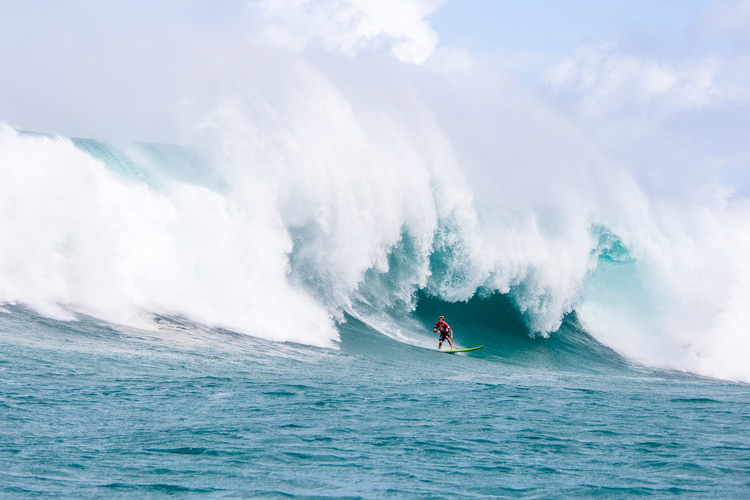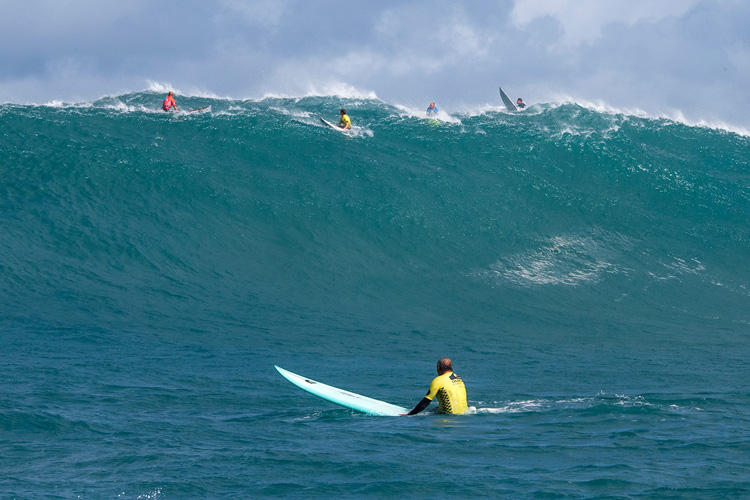Do you know what to do to survive the ultimate surfing punishment? Learn how to confront the endless rows of rumbling whitewater and get out of it alive.
Taking a 20-foot set on the head is not the most pleasant experience surfing has to offer.
And sometimes, a couple of double overhead waves will do the same job, especially in close-out conditions and shallow waters.
In most cases, you can avoid eating the giant sets by monitoring the horizon lines or calculating the wave period.
Every surfer should know how to measure the time between sets, line up properly, and triangulate. These basic skills will help you escape the liquid guillotines, or at least a grand majority of them.
However, Nature has its moods, and sooner or later, a freak set will inevitably catch you by surprise.
When it happens, you must be prepared to press the auto-save button. The volume and mass of a wave are directly proportional to the fear level measured in your brain.
Fear is good, though.
You should be fit to tackle big surf - that is the only way to be ready to deal with tricky situations like a two-wave hold-down.
When you find yourself caught inside by a huge set, let your experience and cold blood handle the situation and come out unhurt.
You can, however, avoid and reduce the number of wipeouts that put you in dangerous situations.
For example, why don't you let the first waves of the set go unridden, particularly in extreme conditions? Why do you ride all your waves to the end?

Relax: Everything Is Going To Be Fine
So, here's what you should do when caught inside and two, three, four, or five incoming mountains are about to smack you down:
- Don't Panic: Fear is good. Panic consumes your energy - everything will be fine, and in a couple of minutes, you will be back on terra firma;
- Control Your Breath: Try to balance your breathing so that fewer resources are spent in the process;
- Stop Paddling: Stop everything and look around for other surfers, surfboards, and obstacles;
- Decide Whether to Duck Dive (a), Dive Forward (b), or Paddle in Towards the Beach (c);
- a) Hold the rails of the board and go for it: remember that you can't, and you shouldn't duck dive huge waves - it's a mistake, and you might get hit by the board;
- b) Don't wait until the last second to dive deep: bigger waves demand early dives, so do it as soon as possible;
- c) Start paddling in, and let the broken waves carry you to dry land;
There are a few breath-holding techniques that will make you feel more comfortable when caught inside.
Keep in mind that if your heart rate is 25 percent higher than what is normal for you, your lung capacity will be dramatically diminished.
And in this chapter, meditation and yoga are fruitful tools because, after all, it's all in the brain.
A bad hold-down is never longer than 30 seconds, so you just need to keep cool, calm, and quiet. For a few, there's always the flotation device option that will help you come to the surface faster.
You should never ditch the board, but if you need to, make sure you grab the rail saver before diving underwater.
When the three-wave hold-down nightmare ends, recover your breath and energy and analyze the conditions.
It is time to decide whether you're ready to give it another go or call it quits.
The question is: how much gas do you have left in the tank? Are you sure you don't need a rest?
It's up to you - find a channel to get back to the lineup or find a current that will bring you back to shore.
Whatever your decision is, congratulations, you've survived a wave hold-down.
